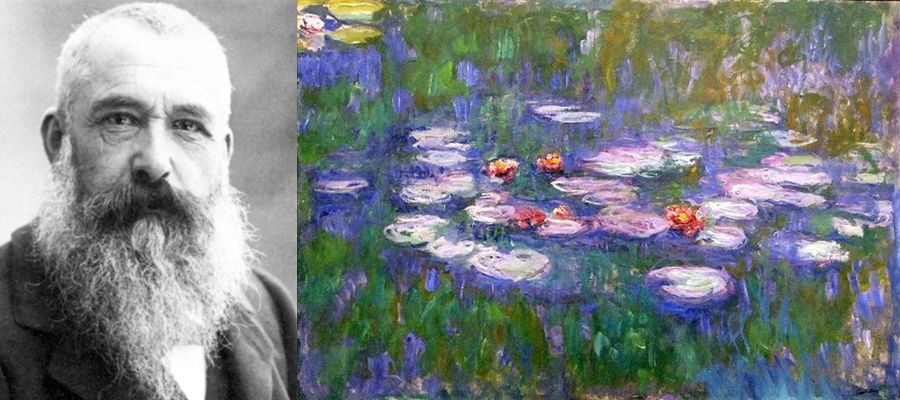
In honor or Claude Monet's birthday (November 14, 1840), following are 10 interesting facts about this amazing artist
Impressionism emerged in France in the middle of the nineteenth century and Claude Monet has been described as the driving force behind this revolutionary art movement. Monet is also painted some of the most famous paintings of the nineteenth century. Here are 10 interesting facts about this pioneer of Impressionist Art.
#1 Monet was an atheist
Claude Monet was born on 14 November 1840 in Paris, France. His father Claude Adolphe Monet had a family grocery business while his mother Louise Justine Aubrée Monet was a singer. Monet was baptized Catholic but he went on to become an atheist. His baptized name was Oscar-Claude, his parents referred to him as simply Oscar but he became famous as Claude Monet.
#2 In his childhood, Claude made caricatures of his teachers
At the age of 5, Claude moved with his family to Le Havre, a port town. Even when he was a child, he loved to draw. He filled his schoolbooks with sketches of people, including caricatures of his teachers. He became famous in the community for his sketches of the town’s residents. His father wanted him to join the family business but his mother supported his artistic endeavors.
#3 Monet served in the military
In 1857, Monet’s mother died and he moved in with his aunt. In 1859, aged 19, he moved to Paris to pursue art. In 1961, however, he joined the First Regiment of African Light Cavalry in Algeria. He had committed to serve the military for seven years but in the second year he contracted typhoid fever. His aunt pleaded with the authorities to release him and they agreed on the condition that Claude would complete an art course at an art school.
#4 He was a student of Swiss artist Charles Gleyre
Claude was disappointed with the traditional art taught at art schools. So he became a student of Swiss artist Charles Gleyre. It was here that Monet met Pierre-Auguste Renoir, Frederic Bazille and Alfred Sisley. Together they discussed new approaches to art like distinctive brush strokes and emphasis on accurate depiction of light in its changing qualities and unusual visual angles. These qualities would later define Impressionist art and all of them would become well-known Impressionist artists.
#5 His first wife Camille Doncieux features in several of his paintings
The painting that first brought recognition to Monet was The Woman in the Green Dress which he painted in 1866. It featured his future wife Camille Doncieux. Camille features in many of his paintings including Women in the Garden, and On the Bank of the Seine, Bennecourt.
#6 Monet painted his wife on her deathbed
Monet and Camille married in 1870 and they had two sons Jean and Michel. Camille was suffering from tuberculosis when her second son was born and in 1878 she was diagnosed with uterine cancer. In 1879, she died at the young age of thirty two. Monet painted her on her deathbed and the work is considered one of the most intensely felt and expressive deathbed paintings.
#7 His second wife was Alice Hoschede
Following the death of Camille, Alice Hoschede helped Monet raise his two sons. Alice had six children of her own and after the death of her estranged husband Monet married Alice Hoschede in 1892. They lived along with their children at Giverny, where Monet painted for the rest of his life.
#8 His painting Impression, Sunrise gave name to the Impressionist movement
In 1872, Monet drew the view from his window of the Le Havre harbor in France. He titled it Impression as it suggested rather than defined. When it was displayed in 1874, it was not well taken by the critics. In a satirical review, Louis Leroy went to the extent of saying: “Wallpaper in its embryonic state is more finished than that seascape.” He titled his review “The Exhibition of the Impressionists” after the painting and thus the new art movement was given a name. The Impressionist movement soon became so popular that it spread to music and literature as well.
#9 Water Lilies Series is considered Monet’s masterpiece
Monet’s series of the “Nympheas” or Water Lilies have been described as “The Sixtine Chapel of Impressionism”. The series consists of approximately 250 oil paintings which were painted by Monet during the last thirty years of his life. They are now on display in museums all around the world. An amazing thing about these works is that Monet’s eyesight was badly deteriorating due to cataract while he painted most of these masterpieces and he could hardly see what he was painting.
#10 Monet died of lung cancer
Monet died of lung cancer on 5 December 1926 at the age of 86 and is buried in the Giverny church cemetery. His house and garden, along with the Museum of Impressionism Giverny are famous tourist attractions in Giverny. Monet’s life was dedicated to finding improved methods of painterly expression. He broke tradition and thought in terms of colors, light and shapes. Some of his series explored how smoke, steam, mist, rain etc. affected color and visibility. In one of his most famous series, twenty-six views of Rouen Cathedral, he broke tradition and cropped the subject so that only a portion of the facade is seen on the canvas. Claude Monet is considered by many, as one of the greatest painters who ever lived.
Credit: learnodo-newtonic.com/claude-monet-facts












